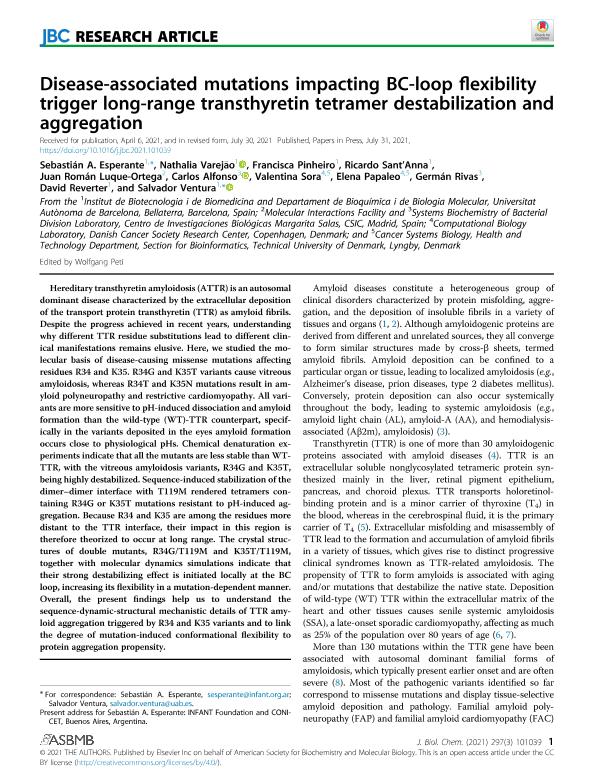Artículo
Disease-associated mutations impacting BC-loop flexibility trigger long-range transthyretin tetramer destabilization and aggregation
Esperante, Sebastian ; Varejao, Nathalia; Pinheiro, Francisca; Sant'Anna, Ricardo; Luque Ortega, Juan Román; Alfonso, Carlos; Sora, Valentina; Papaleo, Elena; Rivas, Germán; Reverter, David; Ventura, Salvador
; Varejao, Nathalia; Pinheiro, Francisca; Sant'Anna, Ricardo; Luque Ortega, Juan Román; Alfonso, Carlos; Sora, Valentina; Papaleo, Elena; Rivas, Germán; Reverter, David; Ventura, Salvador
 ; Varejao, Nathalia; Pinheiro, Francisca; Sant'Anna, Ricardo; Luque Ortega, Juan Román; Alfonso, Carlos; Sora, Valentina; Papaleo, Elena; Rivas, Germán; Reverter, David; Ventura, Salvador
; Varejao, Nathalia; Pinheiro, Francisca; Sant'Anna, Ricardo; Luque Ortega, Juan Román; Alfonso, Carlos; Sora, Valentina; Papaleo, Elena; Rivas, Germán; Reverter, David; Ventura, Salvador
Fecha de publicación:
09/2021
Editorial:
American Society for Biochemistry and Molecular Biology
Revista:
Journal of Biological Chemistry (online)
ISSN:
0021-9258
Idioma:
Inglés
Tipo de recurso:
Artículo publicado
Clasificación temática:
Resumen
Hereditary transthyretin amyloidosis (ATTR) is an autosomal dominant disease characterized by the extracellular deposition of the transport protein transthyretin (TTR) as amyloid fibrils. Despite the progress achieved in recent years, understanding why different TTR residue substitutions lead to different clinical manifestations remains elusive. Here, we studied the molecular basis of disease-causing missense mutations affecting residues R34 and K35. R34G and K35T variants cause vitreous amyloidosis, whereas R34T and K35N mutations result in amyloid polyneuropathy and restrictive cardiomyopathy. All variants are more sensitive to pH-induced dissociation and amyloid formation than the wild-type (WT)-TTR counterpart, specifically in the variants deposited in the eyes amyloid formation occurs close to physiological pHs. Chemical denaturation experiments indicate that all the mutants are less stable than WTTTR, with the vitreous amyloidosis variants, R34G and K35T, being highly destabilized. Sequence-induced stabilization of the dimer-dimer interface with T119M rendered tetramers containing R34G or K35T mutations resistant to pH-induced aggregation. Because R34 and K35 are among the residues more distant to the TTR interface, their impact in this region is therefore theorized to occur at long range. The crystal structures of double mutants, R34G/T119M and K35T/T119M, together with molecular dynamics simulations indicate that their strong destabilizing effect is initiated locally at the BC loop, increasing its flexibility in a mutation-dependent manner. Overall, the present findings help us to understand the sequence-dynamic-structural mechanistic details of TTR amyloid aggregation triggered by R34 and K35 variants and to link the degree of mutation-induced conformational flexibility to protein aggregation propensity.
Palabras clave:
TRANSTHYRETIN
,
AMYLOIDOSIS
,
MUTATIONS
,
AGGREGATION
Archivos asociados
Licencia
Identificadores
Colecciones
Articulos(IIBBA)
Articulos de INST.DE INVEST.BIOQUIMICAS DE BS.AS(I)
Articulos de INST.DE INVEST.BIOQUIMICAS DE BS.AS(I)
Citación
Esperante, Sebastian; Varejao, Nathalia; Pinheiro, Francisca; Sant'Anna, Ricardo; Luque Ortega, Juan Román; et al.; Disease-associated mutations impacting BC-loop flexibility trigger long-range transthyretin tetramer destabilization and aggregation; American Society for Biochemistry and Molecular Biology; Journal of Biological Chemistry (online); 297; 3; 9-2021; 1-14
Compartir
Altmétricas



